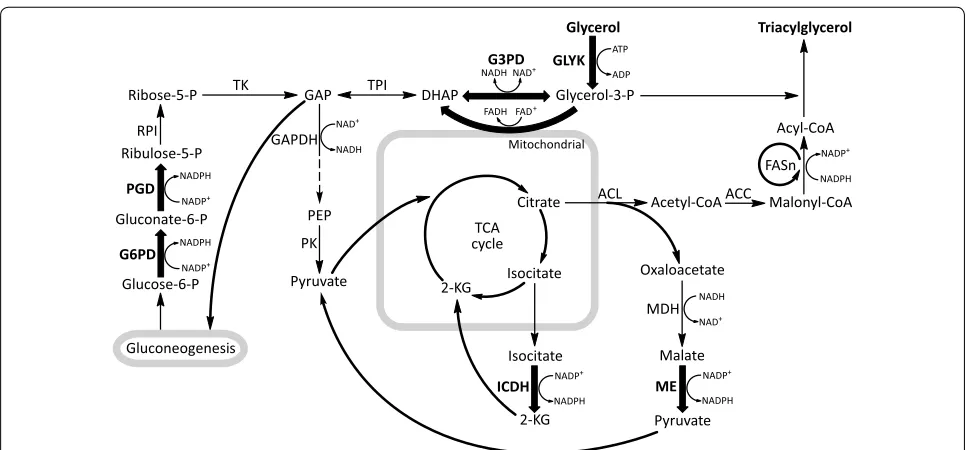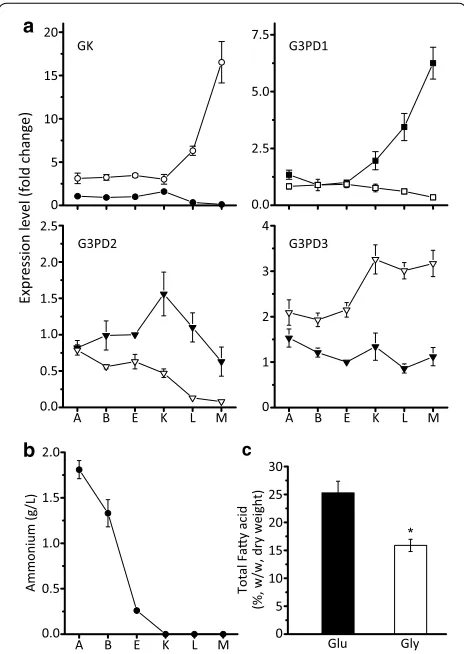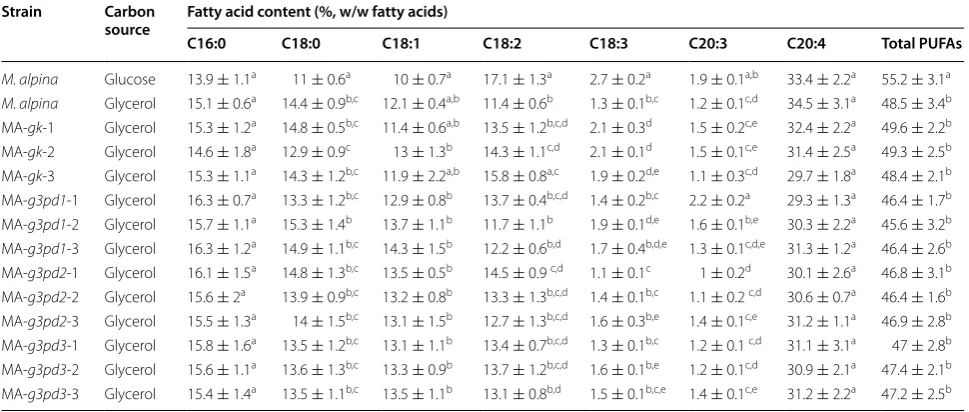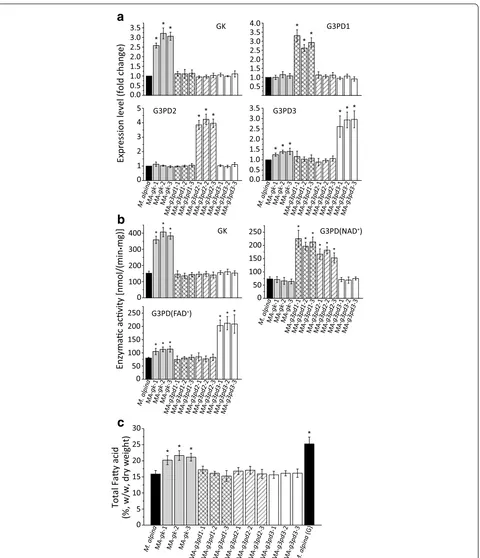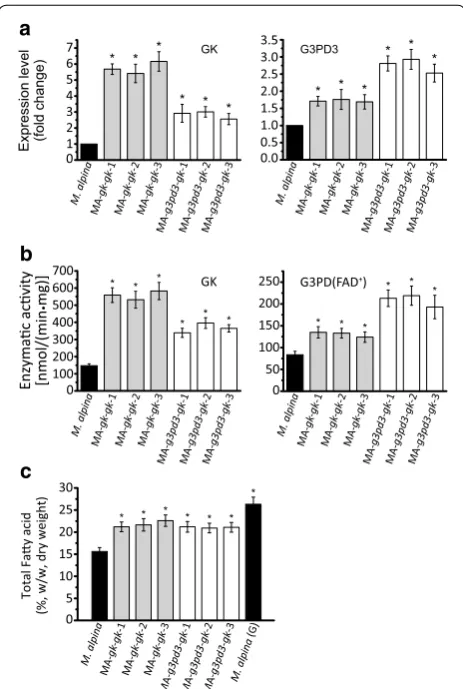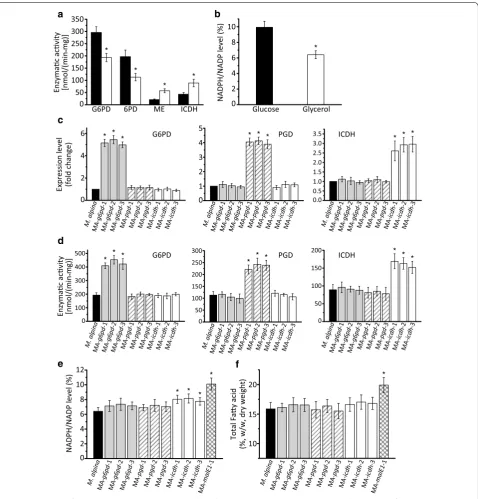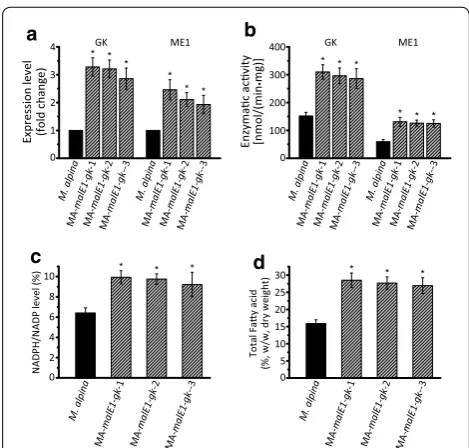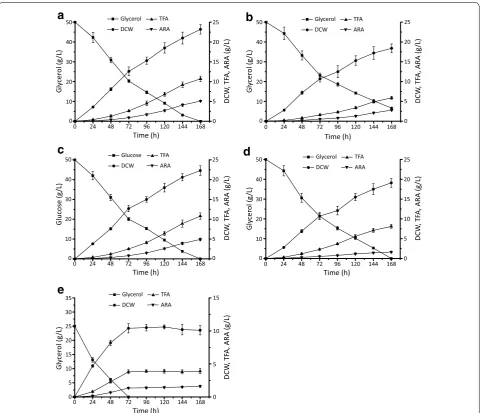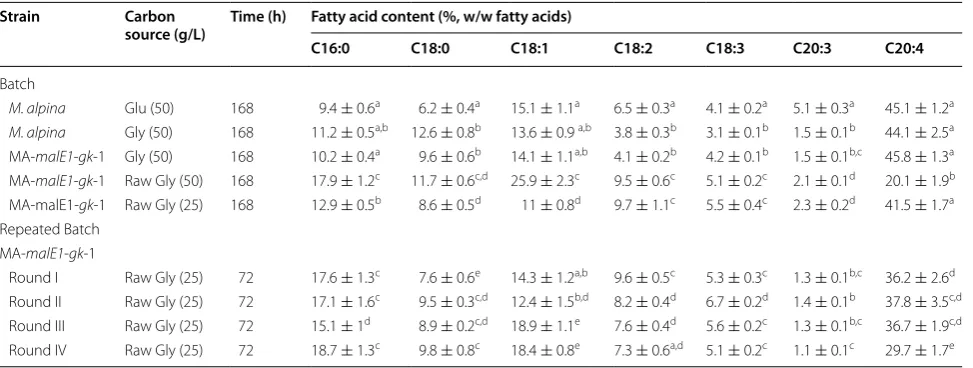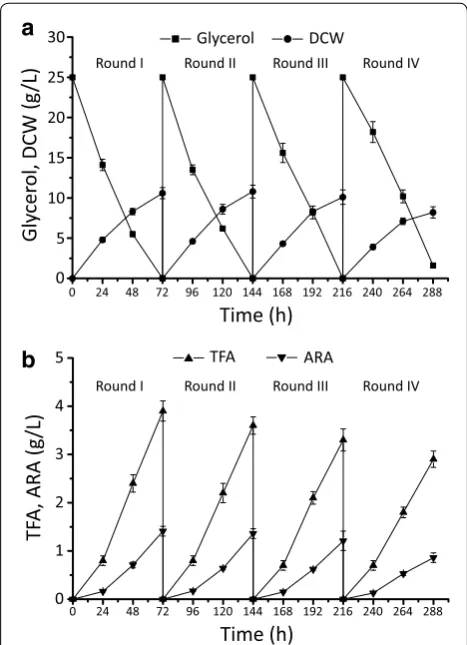RESEARCH
Metabolic engineering of
Mortierella
alpina
for arachidonic acid production
with glycerol as carbon source
Guangfei Hao
1, Haiqin Chen
1,2*, Zhennan Gu
1,2, Hao Zhang
1,2, Wei Chen
1,2,3and Yong Q. Chen
1,2,4Abstract
Background: Although some microorganisms can convert glycerol into valuable products such as polyunsaturated fatty acids, the yields are relative low due primarily to an inefficient assimilation of glycerol. Mortierella alpina is an oleaginous fungus which preferentially uses glucose over glycerol as the carbon source for fatty acid synthesis. Results: In the present study, we metabolically engineered M. alpina to increase the utilization of glycerol. Glycerol kinase and glycerol-3-phosphate dehydrogenase control the first two steps of glycerol decomposition. GK overex-pression increased the total fatty acid content by 35 %, whereas G3PD1, G3PD2 and G3PD3 had no significant effect. Overexpression of malic enzyme (ME1) but not glucose-6-phosphate dehydrogenase, 6-phosphogluconate dehy-drogenase or isocitrate dehydehy-drogenase significantly increased fatty acid content when glycerol was used as carbon source. Simultaneous overexpression of GK and ME1 enabled M. alpina to accumulate fatty acids efficiently, with a 44 % increase in fatty acid content (% of dry weight), a 57 % increase in glycerol to fatty acid yield (g/g glycerol) and an 81 % increase in fatty acid production (g/L culture). A repeated batch process was applied to relieve the inhibitory effect of raw glycerol on arachidonic acid synthesis, and under these conditions, the yield reached 52.2 ± 1.9 mg/g. Conclusions: This study suggested that GK is a rate-limiting step in glycerol assimilation in M. alpina. Another restrict-ing factor for fatty acid accumulation was the supply of cytosolic NADPH. We reported a bioengineerrestrict-ing strategy by improving the upstream assimilation and NADPH supply, for oleaginous fungi to efficiently accumulate fatty acid with glycerol as carbon source.
Keywords: Mortierella alpina, Fatty acid production, Raw glycerol, NADPH
© 2015 Hao et al. This article is distributed under the terms of the Creative Commons Attribution 4.0 International License (http:// creativecommons.org/licenses/by/4.0/), which permits unrestricted use, distribution, and reproduction in any medium, provided you give appropriate credit to the original author(s) and the source, provide a link to the Creative Commons license, and indicate if changes were made. The Creative Commons Public Domain Dedication waiver (http://creativecommons.org/publicdomain/ zero/1.0/) applies to the data made available in this article, unless otherwise stated.
Background
Biodiesel is a widely accepted renewable energy source that has been added to fossil fuels for many years [1]. Glycerol is the major biodiesel byproduct, which consti-tute approximately 80 % of the biodiesel-derived waste, and has become an environmental burden since it can neither be largely consumed by the traditional fermenta-tion industry nor efficiently burned as fuel [2, 3]. Micro-biological conversion of glycerol into organic chemical materials is a promising and rapidly developing solution
[3–5]. In pursuit of a higher commercial added-value to relieve the pressure for cost-efficiency, the use of glycerol to produce polyunsaturated fatty acids (PUFAs) has gath-ered increasing interest in recent years [6].
Some oleaginous microorganisms can grow with glyc-erol as the sole carbon source to accumulate PUFAs [7–
10]. When using glycerol as carbon source, the key issue is the relatively low assimilation efficiency that limits down-stream metabolic processes. This is presumably due to the insufficient coordination of the enzymes involved in the primary metabolic steps of glycerol assimilation [7, 10, 11]. During aerobic growth, glycerol is catabolized by glycerol kinase (GK, EC 2.7.1.30) to glycerol-3-phosphate, which can be used either as a precursor for lipid biosynthesis or converted by glycerol-3-phosphate dehydrogenase (G3PD,
Open Access
*Correspondence: haiqinchen@jiangnan.edu.cn
1 State Key Laboratory of Food Science and Technology, School of Food Science and Technology, Jiangnan University, Wuxi 214122, People’s Republic of China
EC 1.1.1.8) to dihydroxyacetone phosphate (DHAP) to enter the glycolysis pathway [12]. Previously, GK and G3PD have been demonstrated as the enzymes responsible for glycerol assimilation in the production of various com-pounds, including 1,2-propanediol [13], succinate [14], lactic acid [15], shikimic acid [16]. In DHA-rich microal-gae Schizochytrium, GK and G3PD were also suggested to play a dominant role in glycerol assimilation [17]. Thus, overexpression of the genes encoding GK and G3PD is a promising way to improve glycerol assimilation for fatty acid production in oleaginous microbes.
In oleaginous microorganisms, NADPH is critical for fatty acid synthesis and is primarily generated from the pentose phosphate pathway (PPP) [18, 19]. In the absence of glucose, the PPP may be affected in several ways to cause a shortage of NADPH for fatty acid accumulation. This insufficiency can hardly be compensated by malic enzyme (ME, EC 1.1.1.40), because it is down-regulated at the transcriptional level during the fatty acid accumulation stage [20]. Isocitrate dehydrogenase (ICDH, EC 1.1.1.42) is believed to be another important NADPH source, but its role during fatty acid syn-thesis needs to be further characterized [21]. This may be another possible reason for the insufficient accumulation of fatty acids when organisms are cultured with glycerol as sole carbon source. For instance, NADPH also plays an impor-tant role in preventing cell damage caused by reactive oxy-gen species such as free radicals, peroxides, lipid peroxides and heavy metals [22, 23]. In cultures with raw glycerol, the insufficient NADPH generation may exacerbate the inhibi-tory effect of residual components such as soap, sodium or potassium salts, methanol and heavy metals on cell prolifer-ation and metabolism [24, 25]. As the purification process is uneconomical for the downstream industrial utilization [3,
24], directly using raw glycerol as feedstock for fermentation will remain the most reasonable choice for future applica-tions. Thus, improvement of the NADPH supplementation is required for oleaginous microbes to accumulate fatty acids when cultured with raw glycerol.
In this study, industrial oleaginous fungus Mortierella alpina was used to study arachidonic acid (ARA) produc-tion with glycerol as sole carbon source. M. alpina has been previously reported to be able to assimilate glycerol and accumulate ARA, but the biomass and ARA produc-tion were significantly affected [25, 26]. The present work aimed at improving PUFAs yield by genetically modify-ing the initial assimilation steps and the availability of NADPH in M. alpina cultured with glycerol (Fig. 1).
Results
GK and G3PD expression levels during lipogenesis in M.
alpina with different carbon sources
First, we analyzed the expression level of GK and G3PDs in a series M. alpina samples prior to (sample A: −12 h,
B: −2 h, E: −30 min) and after (sample K: +1 h, L: +12 h and M: +48 h) nitrogen exhaustion during fatty acid syn-thesis by RT-qPCR as previously described [18]. When samples were cultured with glucose, the expression of GK kept decreasing to reach an extremely low level during the fatty acid accumulation stage (K, L, M). Meanwhile, the expression of G3PD1 (NAD+) was increased more
than fivefold, and the expression of the other G3PDs was not significantly downregulated (Fig. 2a) after nitrogen exhaustion (Fig. 2b). These results were consistent with the previously performed transcriptome analysis, and indicated that the G3PDs may play an important role during fatty acid accumulation in M. alpina [18]. When samples were cultured with glycerol, the expression level of GK was significantly increased by more than 15-fold to enable the first assimilation step of glycerol. By con-trast, the G3PDs were differently regulated: NAD+
dependent G3PD1 and G3PD2 were significantly down-regulated at the transcript level, while the expression of FAD+ dependent G3PD3 increased by more than
two-fold (Fig. 2a). This may indicate that GK and G3PD3 play important roles during glycerol assimilation. G3PD1 and G3PD2 were still moderately expressed, so they may also be functional.
Overexpression of GK and G3PDs in M. alpina
When M. alpina was cultured with glycerol, the fatty acid content and PUFAs amounts were significantly lower than in the presence of glucose (Fig. 2c, Table 1), indicating a lower fatty acid accumulation and desatura-tion efficiency. However, no negative impact of glycerol on the content of ARA was observed (Table 1), which is consistent with previously reported data [27]. Due to the decrease of the biomass and fatty acids (from 10.3 ± 0.6 to 8.1 ± 0.3 g/L and from 2.6 ± 0.2 to 1.3 ± 0.1 g/L, respectively), the production of ARA was eventually reduced by approximately 49 % (Table 2).
To increase the glycerol assimilation efficiency in M. alpina, the genes encoding GK and three isoforms of G3PD were independently overexpressed by introduc-ing an additional copy of each gene under a homologous His 550 promoter. The inserted expression cassettes in the genome were identified by PCR with two pairs of promoter and terminator specific primers [20, 28].
gene (gk) overexpressing strains; this may be due to an increase in the substrate (glycerol-3-phosphate) gener-ated by GK. The same trend was also detected in terms of the enzymatic activity of GK and G3PDs (Fig. 3b). When
gk was overexpressed, the fatty acid content significantly increased by over 35 % compared to control. By contrast, none of the G3PD overexpressing strains exhibited any improvement in fatty acid content (Fig. 3c).
Next, we wondered if increasing further GK expression level by augmenting its copy number could improve the assimilating efficiency of glycerol in M.alpina. However, further increased expression of GK may now cause G3PD to be a limiting step. Therefore, gk was double-introduced into M. alpina or co-introduced with g3pd3. The tran-script levels of gk and g3pd3 in each double- or co- over-expressing strain were significantly higher than before (Fig. 4a), as well as their enzymatic activities (Fig. 4b). However, the fatty acids were not further accumulated compared to strains with single gene overexpression (Fig. 4c). This suggests that there are other limiting fac-tors that affect fatty acid synthesis when M. alpina is grown with glycerol as carbon source.
NADPH levels in M. alpina with different carbon sources
NADPH is the reducing power for fatty acid synthesis and has been proved as the decisive factor that deter-mines fatty accumulation in oleaginous fungi [30, 31].
Recently, the PPP was identified to be a key step during fatty acid synthesis, mainly by providing NADPH [18,
19]. We noted that, in the absence of glucose, the activi-ties of glucose-6-phosphate dehydrogenase (G6PD, EC 1.1.1.49) and 6-phosphogluconate dehydrogenase (PGD, EC 1.1.1.44) were significantly decreased and remained at moderate levels (Fig. 5a). Accordingly, cell NADPH level decreased to a relatively low level (Fig. 5b). This may lead to another bottleneck when the assimilation efficiency of glycerol is adequately improved. ME has already been demonstrated to be an important NADPH source for fatty acid synthesis [20]. Alternatively, ICDH is another potential NADPH supplier that needs to be further ana-lyzed in order to determine its role in fatty acid synthesis compared to ME [21].
Overexpression of G6PD, PGD and ICDH in M. alpina
To provide a better NADPH source in M. alpina, the genes encoding G6PD, PGD and ICDH (identified or speculated as critical steps for fatty acid synthesis) were overexpressed independently [18, 21]. The transcript level and enzymatic activity of each of three strains that overexpressed a different single genes were ana-lyzed, with wild-type M. alpina as control. All the over-expressing strains exhibited improved transcript level and enzymatic activity, respectively (Fig. 5c and d). The cytosolic NADPH level was further analyzed, along
Glycerol
Glycerol-3-P DHAP
GAP
PEP Acetyl-CoA Malonyl-CoA
Acyl-CoA Triacylglycerol
ATP
ADP
NADP+
NADPH
FASn
NAD+
NADH
Oxaloacetate
Malate
NAD+
NADH
NADP+
NADPH
Pyruvate
Citrate TCA cycle
Isocitate
Isocitate 2-KG
2-KG Pyruvate
Mitochondrial
NADP+
NADPH
NAD+
NADH
FAD+
FADH
GLYK G3PD
ICDH ME
TPI
GAPDH
PK
MDH
ACL ACC
Glucose-6-P
Gluconeogenesis Gluconate-6-P
Ribose-5-P
Ribulose-5-P
NADP+
NADPH
NADP+
NADPH
G6PD PGD RPI
TK
with the ME1 gene (malE1) overexpressing strain
MA-malE1-1 (Fig. 5e; Additional file 1: Fig S1A). In the icdh
overexpressing strains, NADPH ratios were significantly improved compared with control, but not as high as in MA-malE1-1 (Fig. 5e). Whereas, the NADPH contents of wet weight (WW) were not significantly improved in
icdh overexpressing strains (Additional file 1: Fig S1A). By contrast, the NADPH levels of the G6PD and PGD overexpressing strains were apparently not affected, which may be due to substrate insufficiency caused by
the absence of glucose in the medium (Fig. 5e; Addi-tional file 1: Fig S1A). Accordingly, fatty acid accumu-lation was also differentially affected by the increased supply of NADPH. As shown in Fig. 5f, the improve-ment of fatty acid content in ICDH gene (icdh) overex-pressing strains reached approximately 17 % of dry cell weight (DCW), compared with 20 % of the MA-malE1-1 strain. The results indicate that ME1 is a better NADPH supplier than G6PD, PGD and ICDH during fatty acid synthesis in M. alpina cultured with glycerol as carbon source.
Co‑overexpression of GK and ME1 in M. alpina
Based on the results above, we deduced that fatty acid accumulation in M. alpina cultured with glycerol was affected by both the assimilation of glycerol and the sup-ply of NADPH, which could be substantially improved by GK and ME1. Therefore, the genes encoding GK and ME1 were co-expressed to further increase PUFA pro-duction compared to single gene overexpression. The transcript level and enzymatic activity of GK and ME1 in three co-overexpressing strains were increased two-fold to threetwo-fold (Fig. 6a and b), and the NADPH level was also improved owing to the overexpression of ME1 (Fig. 6c; Additional file 1: Fig S1B). The fatty acid content increased by approximately 80 % compared to wild type control after culture in Kendrick medium for 168 h in shaking flasks (Fig. 6d).
Batch fermentation of MA‑malE1‑gk‑1 on glycerol
Batch fermentations were carried out in order to sys-tematically analyze fatty acid production of the engi-neered M. alpina strain MA-malE1-gk-1. The total fatty acid (TFA) and ARA production reached 10.7 ± 0.6 and 4.9 ± 0.3 g/L, respectively (Fig. 7a, Table 3), after being fermented with 50 g/L glycerol for 168 h. Compared with wild-type M. alpina, the TFA content (% of DCW) and production (g/L culture) of MA-malE1-gk-1 increased by approximately 44 % and 81 %, respectively (Fig. 7b) and reached levels comparable to those observed when cul-tured with glucose (Fig. 7c).
As purification cost is relatively expensive, directly using raw glycerol as a substrate to produce high value added products has becoming the most reasonable way to make use of waste glycerol. The performance of the
MA-malE1-gk-1 strain co-overexpressing malE1 and gk on 50 g/L raw glycerol as substrate was evaluated (Fig. 7d). The production of TFA and ARA was significantly affected by the impurity of raw glycerol and decreased to 8.1 ± 0.5 and 1.6 ± 0.1 g/L, respectively (Fig. 7d, Table 3). Notably, the mycelium morphology was found to be basi-cally filamentous, which may increase the medium vis-cosity and affect the absorption of the substrate as well
20 15 10 5 0
Expr
ession level (f
old change
)
GK
0.0 5.0 2.5 7.5
G3PD1
0.0 0.5 1.0 1.5 2.0 2.5
G3PD2
0 1 2 3 4
A B E K L M
G3PD3
A B E K L M
0 5 10 15 20 25 30
Glu Gly
(%, w/w, dry weight
)
a
b
A B E K L M
0.0 0.5 1.0 1.5 2.0
Ammonium (g/L
)
c
*
Fig. 2 a Expression levels of GK and G3PDs in M. alpina growing with glucose or glycerol as carbon source. M. alpina was cultured in a 7.5 L fermenter and sampled at various time points prior to and after nitrogen exhaustion (sample A: −12 h, B: −2 h, E: −30 min, K:
as the accumulation of ARA. As a result, the ARA con-tent only reached 20 % of TFA after being fermented for 168 h (Table 4). Thus, the raw glycerol in the fermenta-tion medium was reduced to 25 g/L and was assimilated and exhausted within 72 h (Fig. 7e). It is noteworthy that, during the first 24 h, the lag phase was shortened and the cells grew faster than when fermented with 50 g/L carbon source (Fig. 7e).
In view of the results, the repeat batch fermenta-tion process that keeps the glycerol and exogenous fatty acids in the medium at a relative low level was applied to improve the production efficiency of fatty acids including ARA (Fig. 8). After a round of fermentation, 10 % of fer-mented broth was retained as the seed for the next round fermentation, supplemented with 3.6 L fresh medium. The four-round repeat batch fermentation lasted 288 h Table 1 Fatty acid composition of different M. alpina strains grown in Kendrick medium for 168 h
M. alpina: wild type M. alpina; MA-gk-1, MA-gk-2 and MA-gk-3: GK overexpressing strains; MA-g3pd1-1, MA- g3pd1-2 and MA-g3pd1-3: G3PD1 overexpressing strains; MA-g3pd2-1, MA-g3pd2-2 and MA-g3pd2-3: G3PD2 overexpressing strains; MA-g3pd3-1, MA-g3pd3-2 and MA-g3pd3-3: G3PD3 overexpressing strains. a,b,c,d,e mean the values within a row with different superscript letters were significantly different (p < 0.05) as analyzed by ANOVA
Strain Carbon
source Fatty acid content (%, w/w fatty acids)
C16:0 C18:0 C18:1 C18:2 C18:3 C20:3 C20:4 Total PUFAs
M. alpina Glucose 13.9 ± 1.1a 11 ± 0.6a 10 ± 0.7a 17.1 ± 1.3a 2.7 ± 0.2a 1.9 ± 0.1a,b 33.4 ± 2.2a 55.2 ± 3.1a
M. alpina Glycerol 15.1 ± 0.6a 14.4 ± 0.9b,c 12.1 ± 0.4a,b 11.4 ± 0.6b 1.3 ± 0.1b,c 1.2 ± 0.1c,d 34.5 ± 3.1a 48.5 ± 3.4b
MA-gk-1 Glycerol 15.3 ± 1.2a 14.8 ± 0.5b,c 11.4 ± 0.6a,b 13.5 ± 1.2b,c,d 2.1 ± 0.3d 1.5 ± 0.2c,e 32.4 ± 2.2a 49.6 ± 2.2b MA-gk-2 Glycerol 14.6 ± 1.8a 12.9 ± 0.9c 13 ± 1.3b 14.3 ± 1.1c,d 2.1 ± 0.1d 1.5 ± 0.1c,e 31.4 ± 2.5a 49.3 ± 2.5b MA-gk-3 Glycerol 15.3 ± 1.1a 14.3 ± 1.2b,c 11.9 ± 2.2a,b 15.8 ± 0.8a,c 1.9 ± 0.2d,e 1.1 ± 0.3c,d 29.7 ± 1.8a 48.4 ± 2.1b MA-g3pd1-1 Glycerol 16.3 ± 0.7a 13.3 ± 1.2b,c 12.9 ± 0.8b 13.7 ± 0.4b,c,d 1.4 ± 0.2b,c 2.2 ± 0.2a 29.3 ± 1.3a 46.4 ± 1.7b MA-g3pd1-2 Glycerol 15.7 ± 1.1a 15.3 ± 1.4b 13.7 ± 1.1b 11.7 ± 1.1b 1.9 ± 0.1d,e 1.6 ± 0.1b,e 30.3 ± 2.2a 45.6 ± 3.2b MA-g3pd1-3 Glycerol 16.3 ± 1.2a 14.9 ± 1.1b,c 14.3 ± 1.5b 12.2 ± 0.6b,d 1.7 ± 0.4b,d,e 1.3 ± 0.1c,d,e 31.3 ± 1.2a 46.4 ± 2.6b MA-g3pd2-1 Glycerol 16.1 ± 1.5a 14.8 ± 1.3b,c 13.5 ± 0.5b 14.5 ± 0.9 c,d 1.1 ± 0.1c 1 ± 0.2d 30.1 ± 2.6a 46.8 ± 3.1b MA-g3pd2-2 Glycerol 15.6 ± 2a 13.9 ± 0.9b,c 13.2 ± 0.8b 13.3 ± 1.3b,c,d 1.4 ± 0.1b,c 1.1 ± 0.2 c,d 30.6 ± 0.7a 46.4 ± 1.6b MA-g3pd2-3 Glycerol 15.5 ± 1.3a 14 ± 1.5b,c 13.1 ± 1.5b 12.7 ± 1.3b,c,d 1.6 ± 0.3b,e 1.4 ± 0.1c,e 31.2 ± 1.1a 46.9 ± 2.8b MA-g3pd3-1 Glycerol 15.8 ± 1.6a 13.5 ± 1.2b,c 13.1 ± 1.1b 13.4 ± 0.7b,c,d 1.3 ± 0.1b,c 1.2 ± 0.1 c,d 31.1 ± 3.1a 47 ± 2.8b MA-g3pd3-2 Glycerol 15.6 ± 1.1a 13.6 ± 1.3b,c 13.3 ± 0.9b 13.7 ± 1.2b,c,d 1.6 ± 0.1b,e 1.2 ± 0.1c,d 30.9 ± 2.1a 47.4 ± 2.1b MA-g3pd3-3 Glycerol 15.4 ± 1.4a 13.5 ± 1.1b,c 13.5 ± 1.1b 13.1 ± 0.8b,d 1.5 ± 0.1b,c,e 1.4 ± 0.1c,e 31.2 ± 2.2a 47.2 ± 2.5b
Table 2 Fatty acid production of different M. alpina strains grown in Kendrick medium for 168 h with glycerol as sole car-bon source
M. alpina: wild type M. alpina; MA-gk-1, MA-gk-2 and MA-gk-3: GK overexpressing strains; MA-g3pd1-1, MA-g3pd1-2 and MA-g3pd1-3: G3PD1 overexpressing strains; MA-g3pd2-1, MA-g3pd2-2 and MA-g3pd2-3: G3PD2 overexpressing strains; MA-g3pd3-1, MA-g3pd3-2 and MA-g3pd3-3: G3PD3 overexpressing strains. a,b,c,d Mean the values within a row with different superscript letters were significantly different (p < 0.05) as analyzed by ANOVA. * Cultured with glucose as carbon source
Strain Biomass (g/L) Fatty acids (g/L) ARA (mg/L) Fatty acid yield (%) ARA yield (%)
M. alpina (Glu*) 10.3 ± 0.6a 2.6 ± 0.2a 87.0 ± 6.1a 7.1 ± 0.5a 2.4 ± 0.2a
M. alpina 8.1 ± 0.3b 1.3 ± 0.1b 44.6 ± 2.9b 4.1 ± 0.2b 1.4 ± 0.1b
MA-gk-1 9.5 ± 1.1a,c 1.9 ± 0.2c 62.0 ± 4.5c 5.2 ± 0.4c,d 1.7 ± 0.1c
MA-gk-2 10.1 ± 0.5a 2.1 ± 0.2d 67.2 ± 4.7c 5.7 ± 0.4c 1.8 ± 0.1c
MA-gk-3 10 ± 0.6a 2.1 ± 0.1c,d 62.8 ± 3.2c 5.9 ± 0.5c 1.7 ± 0.1c
MA-g3pd1-1 8.5 ± 0.4b,c 1.5 ± 0.1b 43 ± 3.1b 4.3 ± 0.4b 1.3 ± 0.1b
MA-g3pd1-2 8.1 ± 0.5b 1.3 ± 0.1b 39.4 ± 2.9b 3.7 ± 0.4b 1.1 ± 0.1d
MA-g3pd1-3 8.4 ± 0.2b 1.3 ± 0.1b 40 ± 3.8b 3.8 ± 0.3b 1.2 ± 0.1b,d
MA-g3pd2-1 8.9 ± 0.7b,c 1.5 ± 0.1b 45 ± 2.4b 4.5 ± 0.3b,d 1.4 ± 0.1b
MA-g3pd2-2 8.7 ± 0.3b,c 1.5 ± 0.1b 45.3 ± 2.1b 4.6 ± 0.2b,d 1.4 ± 0.1b
MA-g3pd2-3 8.4 ± 0.5b,c 1.3 ± 0.1b 41.8 ± 2.6b 4.2 ± 0.3b 1.3 ± 0.1b
MA-g3pd3-1 8.6 ± 0.7b,c 1.3 ± 0.1b 41.7 ± 3.4b 4 ± 0.3b 1.2 ± 0.1b,d
MA-g3pd3-2 8.8 ± 0.4b,c 1.4 ± 0.1b 43.9 ± 4.1b 4.3 ± 0.2b 1.3 ± 0.1b
0.0 0.5 1.0 1.5 2.0 2.5 3.0 3.5 * * * 0.5 1.0 1.5 2.0 2.5 3.0 3.5 4.0 * * * 0 1 2 3 4 5 ** * GK G3PD1 3 D P 3 G 2 D P 3 G
Expression level (fold change
)
M. alpinaMA -gk-1
MA -gk-2
MA -gk-3
MA -g3pd1 -1 MA -g3pd 1-2 MA -g3pd 1-3 MA -g3pd 2-1 MA -g3pd2 -2 MA -g3pd2 -3 MA -g3pd3 -1 MA -g3pd3 -2 MA -g3pd3 -3 0.0 0.5 1.0 1.5 2.0 2.5 3.0
3.5 * * *
* * * 0 5 15 25 30 20 10 * * * *
M. alpinaMA -gk-1
MA -gk-2
MA -gk-3
MA -g3pd 1-1 MA -g3pd 1-2 MA -g3pd 1-3 MA -g3pd 2-1 MA -g3pd 2-2 MA -g3pd 2-3 MA -g3pd 3-1 MA -g3pd3 -2 MA -g3pd 3-3 M. alpina (G)
(%, w/w, dry weight
)
a
b
c
• mg)] GK 0 50 100 150 200 250 * * * * * *G3PD(NAD+)
0 50 100 150 200
250 G3PD(FAD+) * * *
* * * 0 100 200 300 400 * * *
M. alpinaMA
-gk-1 MA
-gk-2 MA
-gk-3
MA -g3pd 1-1 MA -g3pd1 -2 MA -g3pd 1-3 MA -g3pd2 -1 MA -g3pd2 -2 MA -g3pd2 -3 M A-g3pd3 -1 MA -g3pd 3-2 MA -g3pd3 -3 M. alpi na MA -gk-1
MA -gk-2
MA -gk-3
M A-g3pd 1-1 MA -g3pd 1-2 MA -g3pd 1-3 MA -g3pd 2-1 MA -g3pd 2-2 MA -g3pd2 -3 MA -g3pd3 -1 MA -g3pd3 -2 MA -g3pd 3-3
M. alpinaMA
-gk-1 MA
-gk-2 MA
-gk-3
MA -g3pd 1-1 MA -g3pd 1-2 MA -g3pd 1-3 MA -g3pd 2-1 MA -g3pd 2-2 MA -g3pd 2-3 MA -g3pd 3-1 MA -g3pd 3-2 MA -g3pd 3-3
and consumed 100 g raw glycerol in total. The repeat batch was ended at round IV, owing to the decreased DCW and ARA production. From rounds I to IV, TFA reached over 30 % of the DCW, which was 10.6 ± 0.6,
10.8 ± 0.5, 10.1 ± 0.9 and 8.2 ± 0.8 g/L (Fig. 8a and b,
Table 3). The ARA content ranged between 35 and 40 % of TFA with an average yield of 52.2 ± 1.9 mg/g glycerol.
Compared with 32.6 ± 1.4 mg/g when fermented with
50 g/L raw glycerol, the repeat batch method improved the yield of ARA by over 60 % (Figs. 7d and 8b, Table 3).
We also noted the DCW and ARA production was increasingly affected from rounds I to IV (Tables 3 and
4). This may be due to mycelium morphology changes from feather-like to a tight pellet, affecting the transfer of nutrients and oxygen [32, 33].
Discussion
In this study, the genes encoding for GK and G3PD in M. alpina were overexpressed in order to determine their effect on fatty acid production with glycerol as carbon source (Fig. 3). However, only GK overexpression significantly improved TFA content, by 35 % compared to the wild type control (Fig. 3c). By contrast, independent overexpression of three G3PDs had no effect on fatty acid accumulation. In human adipose tissue, the NAD+ dependent G3PD was
reported to catalyze reaction in both directions with a simi-lar efficiency [34]. It is possible that G3PD1 and G3PD2 in
M. alpina have similar characteristics, and thus overexpres-sion of these genes would not increase glycerol assimilation (Fig. 3b). In case of the FAD+ dependent G3PD3, it favors
the formation of DHAP [35]. Interestingly, endogenous G3PD3 expression seems to be regulated by its substrate level. When GK was overexpressed, the transcription of G3PD3 was also increased, as well as its enzymatic activity (Fig. 3a and b). In addition, overexpression alone or in com-bination with GK did not significantly affect TFA accumula-tion. These results reinforce the idea that GK but not G3PD is the limiting step during glycerol assimilation in M. alpina.
The supply of cytosolic NADPH, which has been dem-onstrated to be critical for fatty acid accumulation in oleaginous fungi, may constitute another limited factor [20]. There are four main cytosolic NADPH sources, i.e. G6PD, PDG, ME and ICDH, their roles during fatty acid synthesis need to be further evaluated. When M. alpina
cultured in glycerol, the PPP was significantly suppressed (Fig. 5a). As a result, the NADPH level was insufficient to sustain a high rate of fatty acid syntheses (Fig. 5b). Overexpression of G6PD and PGD neither significantly improved the NADPH level nor the fatty acid accumu-lation. This may be because, in the absence of glucose, there is a low level of substrate for the PPP. Overexpres-sion of ICDH increased NADPH level, but the extent was too slight to have an impaction on fatty acid accu-mulation (Fig. 5e). This may due to the insufficient cyto-solic isocitrate generation that relies on a partial reverse of TCA for lipogenesis [36]. But this catalytic flux was indicated not as persisted as its forward direction [37]. Overexpression of ME1 had the most significant effect on NADPH level and fatty acid synthesis. Subsequently, ME1 was co-overexpressed with GK in the MA-malE1
-Gk-1 strain of M. alpina. In the presence of pure glycerol the TFA levels increased by 81 % compared to the wild-type control. When M.alpina grow with glycerol as sole Expression level (fold change)
0 1 2 3 4 5 6 7 * * * * * * GK 0.0 0.5 1.0 1.5 2.0 2.5 3.0 3.5 * * * * * * G3PD3 0 100 200 300 400 500 600 700 * * * * * * GK [nmol/(min • mg)] * * * * * * 0 50 100 150 200
250 G3PD(FAD+)
0 5 15 25 30 20 10
(%, w/w, dry weight
) * * * * * * * M. alpina MA -gk-g k-1 MA - g3pd3-gk-1 MA -gk-g k-2 MA -gk-g k-3 MA -g3pd3-g k-2 MA -g3pd3-gk -3
M. a lpin
a (G
) a b c M. alpina MA -gk-gk -1 MA -g3pd3-gk -1 MA -gk-g k-2 MA -gk-g k-3 MA -g3pd3-gk -2 MA -g3pd3-gk -3 M. alpi na MA -gk-g k-1 MA -g3p d3-gk -1 MA -gk-gk -2 M A-gk-gk -3 MA -g3pd 3-gk -2 MA -g3pd3-gk
-3 M. alpina MA -gk-g k-1 MA -g3pd3-gk -1 MA -gk-gk -2 MA -gk-g k-3 M A-g3pd3-gk -2 MA -g3pd3-gk -3 M. al pina M A-gk-gk -1 M A-g3pd3-g k-1 M A-gk-g k-2 M A-gk-g k-3 MA -g3pd
3-gk
-2
MA -g3pd3-g
k-3
carbon source, the role of ME became more prominent due to the inability of PPP to provide NADPH needed for fatty acid synthesis.
When raw glycerol is directly used as carbon source, its impurity will affect M. alpina proliferation and in grow-ing and fatty acid synthesis, especially the PUFAs [25, 38].
M. alpina MA -g6pd -1 MA -g6pd -2 MA -g6pd -3 MA -pg d-1 MA -pg d-2 MA -pg d-3 MA -icd h-1 MA -icd h-2 MA -icd h-3 G6PD M. alpina MA -g6pd -1 M A-g6pd -2 MA -g6pd -3 M A-pgd -1 MA -pg d-2 MA -pg d-3 MA -icd h-1 MA -icdh -2 MA -icd h-3 PGD 0.0 0.5 1.0 1.5 2.0 2.5 3.0
3.5 ICDH * * *
M. alpina MA -g6 pd-1 MA -g6pd -2 MA -g6 pd-3 MA -pg d-1 MA -pg d-2 M A-pgd -3 MA -icd h-1 M A-icdh -2 MA -icdh -3 Expression leve l (fold change ) 0 50 100 150 200 250 350 300 [nmol/(min • mg)] * * * *
G6PD 6PD ME ICDH
a b * 0 2 4 6 8 10
NADPH/NADP level (%
) Glucose Glycerol c [nmol/(min • mg)] d
NADPH/NADP level (%
) M. alpina MA -g6 pd-1 MA -g6pd -2 MA -g6pd -3 MA -pgd -1 MA -pgd -2 MA -pg d-3 MA -icd h-1 MA -icd h-2 MA -icd h-3 MA -mal
E1-1 * * * * 0 2 4 6 8 10 12 e * 10 15 20
M. al pina MA -g6pd -1 MA -g6 pd-2 MA -g6pd -3 MA -pgd -1 MA -pg d-2 MA -pgd -3 MA -icdh -1 M A-icdh -2 MA -icd h-3 MA -mal
E1-1
(%, w/w, dry weight
)
f 0
2 4
6 * * *
0 1 2 3 4 5 * * * G6PD 0 100 200 400 300 500 * * * M. alpina MA -g6pd -1 MA -g6pd -2 MA -g6pd -3 MA -pgd
-1
MA -pgd
-2 MA -pgd -3 MA -icdh -1 MA -icd h-2 MA -icd
h-3 0 50 100 150 200 250 300
* * * PGD
M. alpina MA -g6pd -1 MA -g6pd -2 MA -g6pd -3 MA -pgd
-1
MA -pgd
-2
MA -pgd
-3 MA -icd h-1 MA -icd h-2 M A-icdh -3 0 50 100 150 200
M. alpina MA -g6pd -1 MA -g6 pd-2 M A-g6pd -3 MA -pgd -1 MA -pgd -2 M A-pgd -3 MA -icd h-1 MA -icd h-2 M A-icdh -3 * * * ICDH
This suppression may probably be due to the exogenous fatty acids that affects the activities of desaturases and elongases [25]. In M. alpina, ARA is the major product and its synthesis is suppressed by these impurities. There-fore, repeated batch method was applied to alleviate the inhibitory effect of raw glycerol, and to shorten the seed cultivation process [39]. The ARA yield improved by over 60 % and the batch was ended after round IV.
Conclusions
In conclusion, we reported a bioengineering strategy, by improving the upstream assimilation and NADPH sup-ply, for oleaginous fungi to efficiently accumulate fatty acid with glycerol as carbon source. The co-overexpres-sion of GK and ME1 improved fatty acid accumulation by 81 % in M. alpina when grown with pure glycerol. When the repeat batch method was applied to relieve the inhib-itory effect of high raw glycerol concentration, ARA yield was improved by 60 %. Therefore, our work represents a significant step toward a high value added strategy of utilizing biodiesel-derived waste and presents new engi-neering insight for the production of other compounds with raw glycerol as carbon source.
Methods
Strains and culture media
Mortierella alpina ATCC 32,222 was cultured on potato dextrose agar (PDA) medium and its uracil auxotrophic strain CCFM 501 [20] was maintained on GY medium, consisting of 30 g/L glucose, 5 g/L yeast extract, 2 g/L KNO3, 1 g/L NaH2PO4 and 0.3 g/L MgSO4·7H2O,
con-taining 5-fluoroorotic acid (5-FOA, 0.5 mg/mL) and ura-cil (0.05 mg/mL). Escherichia coli top 10 was cultivated at 37 °C on LB agar plates and used for plasmid construc-tion. Agrobacterium tumefaciens C58C1 was cultivated at 28 °C on YEP medium consisting of 10 g/L tryptone, 10 g/L yeast extract and 5 g/L NaCl and used as T-DNA donor for fungal transformation. The composition of the minimal medium (MM) and induction medium (IM) were previously described [40]. The composition of the synthetic complete (SC) medium, which was used for the positive selection of the transformants, was described before [28]. Kendrick medium [29] was used for the fatty acid analysis in flask culture of M. alpina strains and consisted of 50 g/L glucose (glycerol), 2.0 g/L diammo-nium tartrate, 7.0 g/L KH2PO4, 2.0 g/L Na2HPO4, 1.5 g/L
MgSO4·7H2O, 1.5 g/L yeast extract, 0.1 g/L CaCl2·2H2O,
8 mg/L FeCl3·6H2O, 1 mg/L ZnSO4·7H2O, 0.1 mg/L
CuSO4·5H2O, 0.1 mg/L Co(NO3)2·6H2O and 0.1 mg/L
MnSO4·5H2O, pH 6.0. The medium used for the batch
fermentation consisted of 50 g/L glucose (glycerol), 5 g/L yeast extract, 1.0 g/L KH2PO4, 0.25 g/L MgSO4·7H2O,
10 g/L KNO3. Raw glycerol with 80 % purity was added to
reach 50 g/L glycerol concentration.
Fermentation conditions
Batch fermentations of M. alpina strains were carried out in a 7.5-L fermenter (BioFlo/CelliGen 115, New Brunswick Scientific, Edison, NJ, USA). The incubation protocols were as previously described [41]. M. alpina was cultured on PDA or GY plates for 3 weeks at 28 °C. Five mL liquid Kendrick medium was added and the spores were scraped with a sterile loop. Three mL of the spore suspension was inoculated into 50 mL Kendrick medium in a 250 mL flask and cultured at 28 °C for 5 days with shaking at 200 rpm. Cultures were blended for eight pulses using a Braun hand blender with 5 s/pulse. Inoculate 0.3 g wet into 50 mL Kendrick medium in a 250 mL flask and cultured at 28 °C for 5 days with shaking at 200 rpm. The above step was repeated once to make the fungal culture in proliferative phase. The proliferative phase cultures were inoculated at 10 % (v/v) into Kendrick medium to form 4 L culture in a 7.5-L fermenter. The temperature was held at 28 °C and the agitation rate was 500 rpm. Air flow rate was maintained at 0.5 vvm, and the pH was maintained at 6.0 by the auto-matic addition of 2 M of KOH and HCl.
* * * *
* *
0 1 2 3
4 GK ME1
M. alpina
MA -mal
E1-gk
-1
MA -mal
E1-gk
-2
MA -malE1-gk
--3
Expression level (fold change
)
M. alpina
MA -mal
E1-gk
-1
MA -malE
1-gk
-2
MA -malE1-gk
--3 0
100 200 300 400
* * GK
*
* ME1
* *
[nmol/(min
•
mg)]
* * *
0 5 10 15 20 25 30
(%, w/w, dry weight
)
0 2 4 6 8
10 * * *
M. alpina
MA
-mal E1-gk
-1
MA -malE1
-gk-2 MA
-malE1-gk
--3
NADPH/NADP level (%
)
b a
d c
M. al pina
MA
-mal E1-gk
-1
MA -mal
E1-gk
-2
MA -mal
E1-g k--3
M. al pina
M
A-malE1
-gk-1 M
A-mal E1-gk
-2
MA
-malE1-g k--3
M. alpina
MA -mal
E1-gk
-1
M
A-mal E1-gk
-2
MA -
malE1-gk--3
Construction of T‑DNA binary vector
The gk, G3PD1 gene (g3pd1), G3PD2 gene (g3pd2), g3pd3, G6PD gene (g6pd), PGD gene (pgd) and icdh were ampli-fied from the M. alpina cDNA with the primer pairs listed in Additional file 1: Table S1. Genes were ligated into the pGEM-T easy vector (Promega, Madison, WI, USA) fol-lowed by a sequence analysis on ABI PRISM 3730. After being digested with appropriate restrict enzymes, genes were ligated into the binary vector pBIG2-ura5 s-ITs [28] to construct single-gene expression vector. Genes were driven by a homologous constitutive His 550 promoter that was commonly used for gene overexpression in M. alpina.
The expression of His 550 promoter might keep decreas-ing after nitrogen exhaustion [20]. Expression cassette was amplified with primer pair InFusF/InFusR and ligated into XbaI digested single gene expression vector using In-Fusion HD Cloning Kit (Clontech Laboratories, Mountain View, CA, USA) to construct co-expression vector.
Agrobacterium tumefaciens‑mediated transformation (ATMT)
Agrobacterium tumefaciens-mediated transformation was performed following a previously described protocol [20]. M. alpina CCFM 501 spores were harvested from Glycerol
DCW
TFA ARA
0 24 48 72 96 120 144 168 0
10 20 30 40 50
0 5 10 15 20 25
Gl
yc
er
ol (g
/L
)
DCW
, TF
A, ARA (g
/L
)
Time (h)
Glucose (g
/L
)
0 10 20 30 40 50
Gl
yc
er
ol (g
/L
)
0 5 10 15 20 25
DCW
, TF
A, ARA (g
/L
)
0 24 48 72 96 120 144 168
Time (h)
0 10 20 30 40 50
0 24 48 72 96 120 144 168
Time (h) 0 24 48 72Time (h)96 120 144 168
0 24 48 72 96 120 144 168
Time (h)
Glycerol DCW
TFA ARA
Glycerol DCW
TFA ARA
Glycerol DCW
TFA ARA Glucose DCW
TFA ARA
0 5 10 15 20 25
DC
W,
TF
A, ARA (g
/L
)
0 5 10 15 20 25
DC
W,
TF
A, ARA (g
/L
)
0 10 20 30 40 50
Gl
yc
er
ol (g
/L
)
Gl
yc
er
ol (g
/L
)
DC
W,
TF
A, ARA (g
/L
)
0 5 10 15
0 10 20 30
5 15 25 35
b
a
d
c
e
GY agar medium cultures (supplemented with 0.05 g/ mL uracil). A. tumefaciens C58C1 was electro trans-formed with the corresponding binary vector as previ-ously described [42] and the transformants were isolated on YEP agar plates supplemented with 100 μg/mL kana-mycin and 100 μg/mL rifampicin, followed by PCR con-firmation of positive transformants. After an induction culture at 28 °C in liquid IM to an OD600nm of 0.8–1.2,
100 μL of the A. tumefaciens suspension was mixed with an equal volume of spore suspension (108/mL) and then
spread on cellophane membranes, which were placed on a solid cocultivation medium (IM containing 5 mM glu-cose). The plates were incubated at 23 °C for 24–72 h in
a dark incubator and transferred to uracil-free SC plates (containing 50 μg/mL cefotaxime and 50 μg/mL spec-tinomycin to inhibit the growth of bacteria), then incu-bated at 25–30 °C until colonies appeared. The mycelium was transferred to fresh SC plates, and the procedure was repeated three times to obtain stable strains. These stable transformed strains were maintained for further analysis. All experiments were carried out in triplicate.
Genomic DNA preparation
M.alpina strains were cultivated in GY liquid medium at 28 °C for 4 days at 200 rpm. Mycelia were harvested and washed twice with sterile water then frozen immediately Table 3 Fatty acid production of different M. alpina strains in batch fermentation
M. alpina: wild type M. alpina; MA-malE1-gk-1: ME1 and GK co-overexpressing strain; Glu glucose; Gly Glycerol; Raw Gly Raw Glycerol. a,b,c,d,e,f mean the values within a row with different superscript letters were significantly different (p < 0.05) as analyzed by ANOVA
Strain Carbon
source (g/L) Time (h) Biomass (g/L) Fatty acids (g/L) ARA (g/L) Fatty acid yield (%) ARA yield (%)
Batch
M. alpina Glu (50) 168 22.3 ± 1.8a 10.2 ± 0.7a 4.6 ± 0.2a 20 ± 1.7a 9.2 ± 0.4a
M. alpina Gly (50) 168 18.4 ± 1.1b 5.9 ± 0.2b 2.6 ± 0.2b 13.6 ± 0.7b,c 6 ± 0.3b
MA-malE1-gk-1 Gly (50) 168 23.2 ± 2.1a 10.7 ± 0.6a 4.9 ± 0.3a 21.4 ± 1.5a 9.8 ± 0.5a
MA-malE1-gk-1 Raw Gly (50) 168 19.1 ± 1.3b 8.1 ± 0.5c 1.6 ± 0.1c 16.2 ± 0.8d 3.3 ± 0.1c MA-malE1-gk-1 Raw Gly (25) 168 10.1 ± 0.9 c,d 3.9 ± 0.6d 1.6 ± 0.2c 15.6 ± 1.2b,d 6.5 ± 0.4b Repeated Batch
MA-malE1-gk-1
Round I Raw Gly (25) 72 10.6 ± 0.6c 3.9 ± 0.1d 1.4 ± 0.1c,d 15.6 ± 1.1b,d 5.6 ± 0.2d
Round II Raw Gly (25) 72 10.8 ± 0.5c 3.6 ± 0.2d,e 1.4 ± 0.1c,d 14.4 ± 1.2b,c,d 5.4 ± 0.3d,e Round III Raw Gly (25) 72 10.1 ± 0.9c,d 3.3 ± 0.2d,e 1.2 ± 0.1d 13.2 ± 0.6c 4.8 ± 0.3e
Round IV Raw Gly (25) 72 8.2 ± 0.8d 2.9 ± 0.2e 0.9 ± 0.1e 12.4 ± 0.9c 4 ± 0.2f
Table 4 Fatty acid composition of different M. alpina strains in batch fermentation
M. alpina: wild type M. alpina; MA-malE1-gk-1: ME1 and GK co-overexpressing strain; Glu glucose; Gly Glycerol; Raw Gly Raw Glycerol. a,b,c,d,e mean the values within a row with different superscript letters were significantly different (p < 0.05) as analyzed by ANOVA
Strain Carbon
source (g/L) Time (h) Fatty acid content (%, w/w fatty acids)
C16:0 C18:0 C18:1 C18:2 C18:3 C20:3 C20:4
Batch
M. alpina Glu (50) 168 9.4 ± 0.6a 6.2 ± 0.4a 15.1 ± 1.1a 6.5 ± 0.3a 4.1 ± 0.2a 5.1 ± 0.3a 45.1 ± 1.2a M. alpina Gly (50) 168 11.2 ± 0.5a,b 12.6 ± 0.8b 13.6 ± 0.9 a,b 3.8 ± 0.3b 3.1 ± 0.1b 1.5 ± 0.1b 44.1 ± 2.5a MA-malE1-gk-1 Gly (50) 168 10.2 ± 0.4a 9.6 ± 0.6b 14.1 ± 1.1a,b 4.1 ± 0.2b 4.2 ± 0.1b 1.5 ± 0.1b,c 45.8 ± 1.3a MA-malE1-gk-1 Raw Gly (50) 168 17.9 ± 1.2c 11.7 ± 0.6c,d 25.9 ± 2.3c 9.5 ± 0.6c 5.1 ± 0.2c 2.1 ± 0.1d 20.1 ± 1.9b MA-malE1-gk-1 Raw Gly (25) 168 12.9 ± 0.5b 8.6 ± 0.5d 11 ± 0.8d 9.7 ± 1.1c 5.5 ± 0.4c 2.3 ± 0.2d 41.5 ± 1.7a Repeated Batch
MA-malE1-gk-1
in liquid nitrogen. Genomic DNA of M. alpina was extracted as described previously [41].
RT‑qPCR analysis
The primer pairs used for RT-qPCR are shown in Addi-tional file 1: Table S1. Total RNA was isolated from M. alpina and reverse-transcribed with the PrimeScript RT reagent kit (Takara Bio, Japan) according to the manu-facturer’s instructions. RT-qPCR was performed on the ABI-Prism 7900 sequence detection system (Applied Bio-systems, CA) with the Power SYBR Green PCR Master Mix (Applied Biosystems, CA). Twenty-microliter reac-tion mixtures composed of 10 µL of SYBR Green PCR Master Mix, 0.5 µL of each primer, 8 µL of distilled water, and 1 µL of DNA template or distilled water as negative control were prepared. The PCR cycling conditions were 50 °C for 2 min, 95 °C for 10 min, followed by 40 cycles of amplification at 95 °C for 15 s and 60 °C for 30 s. The
expression of the internal control gene (18S rRNA) was used as the normalization standard for gene expression. All of the samples were measured in triplicate.
Determination of enzymatic activities
Mycelium was harvested by filtration, then frozen and ground in liquid nitrogen and suspended in the previ-ously described extraction buffer [28]. The activity of ME, ICDH, G6PD and PGD was determined as described before [20, 43, 44]. GK and FAD+ dependent G3PD
activity was determined as described previously [45,
46]. NAD+ dependent G3PD activity was determined as
described previously [47].
NADP and NADPH quantification
Essentially as described previously [20], samples were rapidly collected and frozen with liquid nitrogen, lyo-philized and ground in liquid nitrogen. The NADP and NADPH levels were analyzed using the NADP/NADPH Quantification Colorimetric Kit (BioVision, California, USA) according to the manufacturer’s instructions.
Fatty acid methyl ester (FAME) analysis
For fatty acid analysis, the M.alpina mycelia were col-lected and lyophilized. Approximately 20 mg of mycelia were used for each lipid extraction. Fatty acid analysis was performed essentially as described previously [41]. FAMEs were subsequently analyzed by GC–MS (GC-2010 Plus; MS-QP(GC-2010 Ultra, Shimadzu Co., Kyoto, Japan) with a 30 m × 0.25 mm Rtx-Wax column (film thickness 0.25 µm) with the temperature program: 40 °C for 5 min, ramp to 120 °C at 20 °C per min, then ramp to 190 °C at 5 °C per min, and hold for 5 min, then ramp to 220 °C at 5 °C per min, and finally hold for 17 min. Helium was used as the carrier gas. Fatty acid quantifica-tion was carried out using peak-height area integrals. A 37-component FAME mix was used for qualitative analy-sis. Pentadecanoic acid and heneicosanoic acid were used as internal standards to quantify the fatty acid methyl esters with aliphatic chain ≤18 and >18, respectively. All experiments were carried out in triplicate.
Statistical analysis
All experiments were carried out in triplicate, and the means and standard errors were calculated. SPSS 20 was used for one-way analysis and canonical correlation anal-ysis, and the significant differences (P < 0.05) were deter-mined by the least significant difference test.
Additional file
Additional file 1: Table S1. Primers used in this study.
Gl
yc
er
ol, DCW (g
/L
)
10 20 30
5 15 25
0 24 48 72 96 120 144 168
Time (h)
0
192 216 240 264 288 Glycerol DCW
TFA ARA
0 1 2 3 4 5
TF
A, ARA (g
/L
)
0 24 48 72 96 120 144 168
Time (h)
192 216 240 264 288a
b
Round I Round II Round III Round IV
Round I Round II Round III Round IV
Abbreviations
GK: glycerol kinase; G3PD: glycerol-3-phosphate dehydrogenase; ME: malic enzyme; G6PD: glucose-6-phosphate dehydrogenase; PGD: 6-phosphoglu-conate dehydrogenase; ICDH: isocitrate dehydrogenase; ARA: arachidonic acid; PUFAs: polyunsaturated fatty acids; DHAP: dihydroxyacetone phosphate; ATMT: Agrobacterium tumefaciens-mediated transformation; GAP: glyceral-dehyde 3-phosphate; PEP: phosphoenolpyruvate; 2-KG: 2-ketoglutarate; TPI: triose phosphate isomerase; GAPDH: glyceraldehyde-3-phosphate dehydroge-nase; PK: pyruvate kidehydroge-nase; RPI: ribose-5-phosphate isomerase; TK: transketolase; ACLATP: citrate synthase; MDH: malate dehydrogenase; ACC: acetyl-CoA car-boxylase; FASn: fatty acid synthase; TFA: total fatty acids; DCW: dry cell weight.
Authors’ contributions
GH designed and carried out this work, and drafted the manuscript. HC analyzed the data and helped to draft the manuscript. ZG and HZ supervised the research and helped to draft the manuscript. WC and YQC conceived and coordinated the study and revised the manuscript. All authors read and approved the final manuscript.
Author details
1 State Key Laboratory of Food Science and Technology, School of Food Sci-ence and Technology, Jiangnan University, Wuxi 214122, People’s Republic of China. 2 Synergistic Innovation Center for Food Safety and Nutrition, Wuxi 214122, People’s Republic of China. 3 Beijing Innovation Centre of Food Nutrition and Human Health, Beijing Technology and Business University (BTBU), Beijing 100048, People’s Republic of China. 4 Departments of Cancer Biology and Biochemistry, Wake Forest School of Medicine, Winston-Salem, NC 27157, USA.
Acknowledgements
This study was supported in part by the National Science Foundation of China (NSFC) (21276108, 31530056, 31471128, 31400038), the Chinese National Science Fund for Distinguished Young Scholars (31125021), the Program for New Century Excellent Talents (NCET-13-0831), the Program for Changjiang Scholars and Innovative Research Team in University (IRT1249), the Fundamen-tal Research Funds for the Central Universities (JUSRP51320B), and National Institutes of Health grants (R01CA107668, R01CA163273).
Competing interests
The authors declared that they have no competing interests.
Received: 14 October 2015 Accepted: 5 December 2015
References
1. Andre A, Diamantopoulou P, Philippoussis A, Sarris D, Komaitis M, Papanikolaou S. Biotechnological conversions of bio-diesel derived waste glycerol into added-value compounds by higher fungi: production of biomass, single cell oil and oxalic acid. Ind Crop Prod. 2010;31(2):407–16.
doi:10.1016/j.indcrop.2009.12.011.
2. Morgunov IG, Kamzolova SV, Lunina JN. The citric acid production from raw glycerol by Yarrowia lipolytica yeast and its regulation. Appl Microbiol Biotechnol. 2013;97(16):7387–97.
3. Gholami Z, Abdullah AZ, Lee K-T. Dealing with the surplus of glycerol production from biodiesel industry through catalytic upgrading to polyglycerols and other value-added products. Renew Sust Energ Rev. 2014;39:327–41. doi:10.1016/j.rser.2014.07.092.
4. Demirbas M, Balat M. Recent advances on the production and utiliza-tion trends of bio-fuels: a global perspective. Energ Convers Manage. 2006;47(15):2371–81.
5. da Silva GP, Mack M, Contiero J. Glycerol: a promising and abundant car-bon source for industrial microbiology. Biotechnol Adv. 2009;27(1):30–9. 6. Huang C, Chen XF, Xiong L, Chen XD, Ma LL, Chen Y. Single cell oil
production from low-cost substrates: the possibility and potential of its industrialization. Biotechnol Adv. 2013;31(2):129–39. doi:10.1016/j.
biotechadv.2012.08.010.
7. Papanikolaou S, Fakas S, Fick M, Chevalot I, Galiotou-Panayotou M, Komaitis M, et al. Biotechnological valorisation of raw glycerol discharged
after bio-diesel (fatty acid methyl esters) manufacturing process: produc-tion of 1, 3-propanediol, citric acid and single cell oil. Biomass Bioenerg. 2008;32(1):60–71.
8. Ethier S, Woisard K, Vaughan D, Wen Z. Continuous culture of the micro-algae Schizochytrium limacinum on biodiesel-derived crude glycerol for producing docosahexaenoic acid. Bioresour Technol. 2011;102(1):88–93. 9. Dedyukhina EG, Chistyakova TI, Kamzolova SV, Vinter MV, Vainshtein MB.
Arachidonic acid synthesis by glycerol-grown Mortierella alpina. Eur J Lipid Sci Tech. 2012;114(7):833–41.
10. Chatzifragkou A, Makri A, Belka A, Bellou S, Mavrou M, Mastoridou M, et al. Biotechnological conversions of biodiesel derived waste glycerol by yeast and fungal species. Energy. 2011;36(2):1097–108. doi:10.1016/j.
energy.2010.11.040.
11. Fakas S, Papanikolaou S, Batsos A, Galiotou-Panayotou M, Mallouchos A, Aggelis G. Evaluating renewable carbon sources as substrates for single cell oil production by Cunninghamella echinulata and Mor-tierella isabellina. Biomass Bioenerg. 2009;33(4):573–80. doi:10.1016/j.
biombioe.2008.09.006.
12. Wang Z, Zhuge J, Fang H, Prior BA. Glycerol production by microbial fermentation: a review. Biotechnol Adv. 2001;19(3):201–23.
13. Jung JY, Lee JW. Production of 1, 2-propanediol from glycerol in Saccha-romyces cerevisiae. J Microbiol Biotechn. 2011;21(8):846–53.
14. Litsanov B, Brocker M, Bott M. Glycerol as a substrate for aerobic succinate production in minimal medium with Corynebacterium glutamicum. Microb Biotechnol. 2013;6(2):189–95.
15. Mazumdar S, Blankschien MD, Clomburg JM, Gonzalez R. Efficient synthe-sis of L-lactic acid from glycerol by metabolically engineered Escherichia coli. Microb Cell Fact. 2013;12(1):7.
16. Yang Y, Yuan \ C, Dou J, Han X, Wang H, Fang H, et al. Recombinant expression of glpK and glpD genes improves the accumulation of shikimic acid in E. coli grown on glycerol. World J Microb Biot. 2014;30(12):3263–72.
17. Chang G, Luo Z, Gu S, Wu Q, Chang M, Wang X. Fatty acid shifts and metabolic activity changes of Schizochytrium sp. S31 cultured on glycerol. Bioresour Technol. 2013;142:255–60.
18. Chen H, Hao G, Wang L, Wang H, Gu Z, lIU L, et al. Identification of a criti-cal determinant that enables efficient fatty acid synthesis in oleaginous fungi. Sci Rep. 2015;5:11247. doi:10.1038/srep11247. http://www.nature.
com/srep/2015/150610/srep11247/abs/srep11247.html#supplementary-information (441)
19. Wasylenko TM, Ahn WS, Stephanopoulos G. The oxidative pentose phos-phate pathway is the primary source of NADPH for lipid overproduction from glucose in Yarrowia lipolytica. Metab Eng. 2015;30:27–39. 20. Hao GF, Chen HQ, Wang L, Gu ZN, Song YD, Zhang H, et al. Role of malic
enzyme during fatty acid synthesis in the oleaginous fungus Mor-tierella alpina. Appl Environ Microbiol. 2014;80(9):2672–8. doi:10.1128/
Aem.00140-14.
21. Ratledge C. The role of malic enzyme as the provider of NADPH in oleagi-nous microorganisms: a reappraisal and unsolved problems. Biotechnol Lett. 2014;36(8):1557–68.
22. Pompella A, Visvikis A, Paolicchi A, De Tata V, Casini AF. The chang-ing faces of glutathione, a cellular protagonist. Biochem Pharmacol. 2003;66(8):1499–503.
23. Kumar C, Igbaria A, D’autreaux B, Planson AG, Junot C, Godat E, et al. Glu-tathione revisited: a vital function in iron metabolism and ancillary role in thiol-redox control. EMBO J. 2011;30(10):2044–56.
24. Khanna S, Goyal A, Moholkar VS. Microbial conversion of glycerol: present status and future prospects. Crit Rev Biotechnol. 2012;32(3):235–62. 25. Dedyukhina EG, Chistyakova TI, Mironov AA, Kamzolova SV, Morgunov IG,
Vainshtein MB. Arachidonic acid synthesis from biodiesel-derived waste by Mortierella alpina. Eur J Lipid Sci Tech. 2014;116(4):429–37.
26. Abad S, Turon X. Valorization of biodiesel derived glycerol as a carbon source to obtain added-value metabolites: focus on polyunsatu-rated fatty acids. Biotechnol Adv. 2012;30(3):733–41. doi:10.1016/j.
biotechadv.2012.01.002.
27. Yu AQ, Zhu JC, Zhang B, Xing LJ, Li M. Effects of different carbon sources on the growth, fatty acids production, and expression of three desaturase genes of Mortierella alpina ATCC 16266. Curr Microbiol. 2011;62(5):1617–22.
over-expression of the mitochondrial malic enzyme in Mortierella alpina. Biotechnol Lett. 2014;36(9):1827–34.
29. Kendrick A, Ratledge C. Desaturation of polyunsaturated fatty acids in Mucor circinelloides and the involvement of a novel membrane-bound malic enzyme. FEBS J. 1992;209(2):667–73.
30. Ratledge C, Wynn JP. The biochemistry and molecular biology of lipid accumulation in oleaginous microorganisms. Adv Appl Microbiol. 2002;51:1–51.
31. Ratledge C. Fatty acid biosynthesis in microorganisms being used for single cell oil production. Biochimie. 2004;86(11):807–15.
32. Ji XJ, Ren LJ, Nie ZK, Huang H, Ouyang PK. Fungal arachidonic acid-rich oil: research, development and industrialization. Crit Rev Biotechnol. 2013;34(3):197–214.
33. Nie ZK, Ji XJ, Shang JS, Zhang AH, Ren LJ, Huang H. Arachidonic acid-rich oil production by Mortierella alpina with different gas distributors. Bioproc Biosyst Eng. 2014;37(6):1127–32.
34. Koekemoer TC, Litthauer D, Oelofsen W. Isolation and characterization of adipose tissue glycerol-3-phosphate dehydrogenase. Int J Biovhem Cell B. 1995;27(6):625–32. doi:10.1016/1357-2725(95)00012-E.
35. Celińska E, Grajek W. A novel multigene expression construct for modi-fication of glycerol metabolism in Yarrowia lipolytica. Microb Cell Fact. 2013;12:102.
36. Filipp FV, Scott DA, Ronai ZeA, Osterman AL, Smith JW. Reverse TCA cycle flux through isocitrate dehydrogenases 1 and 2 is required for lipogenesis in hypoxic melanoma cells. Pigment Cell Melanoma Res. 2012;25(3):375–83.
37. Fan J, Kamphorst JJ, Rabinowitz JD, Shlomi T. Fatty acid labeling from glutamine in hypoxia can be explained by isotope exchange with-out net reductive isocitrate dehydrogenase (IDH) flux. J Biol Chem. 2013;288(43):31363–9.
38. Chatzifragkou A, Papanikolaou S. Effect of impurities in biodiesel-derived waste glycerol on the performance and feasibility of biotechnological processes. Appl Microbiol Biotechnol. 2012;95(1):13–27.
39. Ji XJ, Zhang AH, Nie ZK, Wu WJ, Ren LJ, Huang H. Efficient arachidonic acid-rich oil production by Mortierella alpina through a repeated fed-batch fermentation strategy. Bioresour Technol. 2014;170:356–60. 40. Ando A, Sumida Y, Negoro H, Suroto DA, Ogawa J, Sakuradani E, et al.
Establishment of Agrobacterium tumefaciens-mediated transformation of an oleaginous fungus, Mortierella alpina 1S-4, and its application for eicosapentaenoic acid producer breeding. Appl Microbiol Biotechnol. 2009;75(17):5529–35. doi:10.1128/AEM.00648-09.
41. Wang L, Chen W, Feng Y, Ren Y, Gu Z, Chen H, et al. Genome char-acterization of the oleaginous fungus Mortierella alpina. PLoS One. 2011;6(12):e28319. doi:10.1371/journal.pone.0028319.
42. Mattanovich D, Ruker F, Machado AC, Laimer M, Regner F, Steinkellner H, et al. Efficient transformation of Agrobacterium spp. by electroporation. Nucleic Acids Res. 1989;17(16):6747.
43. Langdon RG. Glucose 6-phosphate dehydrogenase from erythrocytes. Method Enzymol. 1966;9:126–31.
44. Pontremoli S, Grazi E. 6-Phosphogluconate dehydrogenase-Crystalline. Method Enzymol. 1966;9:137–41.
45. Lin E, Koch J, Chused T, Jorgensen S. Utilization of l-α-glycerophosphate by Escherichia coli without hydrolysis. Proc Natl Acad Sci USA. 1962;48(12):2145.
46. Janssen MJ, van Voorst F, Ploeger GE, Larsen PM, Larsen MR, de Kroon AI, et al. Photolabeling identifies an interaction between phosphati-dylcholine and glycerol-3-phosphate dehydrogenase (Gut2p) in yeast mitochondria. Biochemistry. 2002;41(18):5702–11.
47. Blomberg A, Adler L. Roles of glycerol and glycerol-3-phosphate dehydro-genase (NAD+) in acquired osmotolerance of Saccharomyces cerevisiae. J Bacteriol. 1989;171(2):1087–92.
• We accept pre-submission inquiries
• Our selector tool helps you to find the most relevant journal
• We provide round the clock customer support
• Convenient online submission
• Thorough peer review
• Inclusion in PubMed and all major indexing services
• Maximum visibility for your research
Submit your manuscript at www.biomedcentral.com/submit
